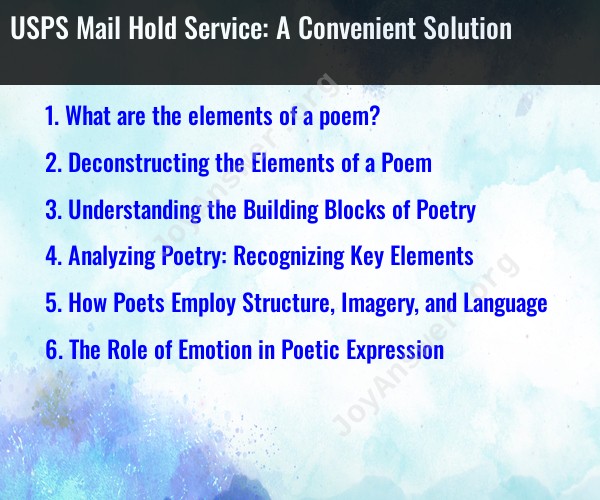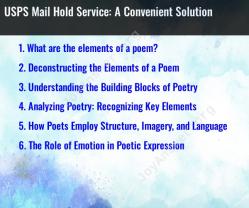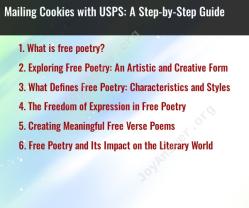What are the elements of a poem?
A poem is a form of literary expression that often relies on a combination of elements to convey meaning, evoke emotions, and create a unique artistic experience. The elements of a poem include:
Structure and Form:
- The structure and form of a poem refer to its organization, including the number and arrangement of lines, stanzas, and rhyme schemes. Poems can take on various forms, from traditional sonnets and haikus to free verse or prose poetry.
Meter:
- Meter is the rhythmic pattern of stressed and unstressed syllables in a line of poetry. It helps establish the poem's rhythm and can vary from poem to poem.
Rhyme:
- Rhyme involves the repetition of similar sounds at the end of words. Rhyming words can appear at the end of lines (end rhyme) or within the same line (internal rhyme). Rhyme schemes can vary, such as AABB, ABAB, or ABCB.
Imagery:
- Imagery is the use of vivid and descriptive language to create mental images and appeal to the reader's senses. Poets use imagery to paint pictures with words and engage the reader's imagination.
Metaphor and Simile:
- Metaphors and similes are figures of speech used to make comparisons. Metaphors imply a direct comparison, while similes use "like" or "as." Both help convey complex ideas or emotions by relating them to familiar concepts.
Symbolism:
- Symbols are objects, images, or concepts that represent deeper meanings and ideas within the poem. They can add layers of meaning and invite interpretation.
Tone:
- The tone of a poem reflects the poet's attitude or emotional stance toward the subject matter. It can be playful, melancholic, ironic, or any other mood.
Theme:
- The theme is the central message or idea conveyed by the poem. It represents the deeper, universal meaning that the poem explores or addresses.
Diction:
- Diction refers to the poet's choice of words and language. The choice of words can impact the poem's tone, style, and overall meaning.
Alliteration:
- Alliteration is the repetition of initial consonant sounds in a line or stanza, contributing to the poem's musical quality and rhythm.
Enjambment:
- Enjambment occurs when a line of poetry continues into the next line without a natural pause or punctuation, creating a sense of momentum or suspense.
Repetition:
- Repetition of words, phrases, or sounds can emphasize specific ideas, create rhythm, or enhance the poem's overall impact.
Narrative:
- Some poems tell a story or describe a sequence of events, while others focus on conveying emotions, thoughts, or observations without a specific narrative.
Sound:
- The sound of a poem, including the choice of words, rhythm, and rhyme, contributes to the overall auditory experience for the reader or listener.
These elements are used by poets to craft their work and create a rich and multi-dimensional experience for the reader. Different poems may emphasize various elements to varying degrees, depending on the poet's style and intentions.
Deconstructing the Elements of a Poem
Poetry is a form of literature that uses words to create a sensory experience for the reader. Poets use a variety of elements to create their poems, including:
- Structure: The structure of a poem refers to the way that the words are arranged on the page. Poems can be written in a variety of different forms, such as sonnets, haikus, and free verse.
- Imagery: Imagery is the use of words to create a picture in the reader's mind. Poets use imagery to evoke specific emotions or memories in the reader.
- Language: Poets use language in unique and creative ways to create their poems. They may use figurative language, such as similes and metaphors, to create more vivid and evocative imagery.
Understanding the Building Blocks of Poetry
The building blocks of poetry are words, phrases, and sentences. Poets arrange these building blocks in a variety of ways to create poems with different meanings and effects.
Some of the most common poetic devices include:
- Simile: A simile is a comparison of two things using the words "like" or "as." For example, "Her eyes were like pools of blue."
- Metaphor: A metaphor is a comparison of two things that are not alike in reality. For example, "Her eyes were pools of fire."
- Personification: Personification is the giving of human qualities to non-human things. For example, "The wind whispered through the trees."
Poets use these devices to create vivid imagery, evoke emotions, and convey their message in a unique and creative way.
Analyzing Poetry: Recognizing Key Elements
When analyzing poetry, it is important to consider the following key elements:
- Structure: What is the structure of the poem? Is it a sonnet, haiku, or free verse? How does the structure contribute to the meaning and effect of the poem?
- Imagery: What imagery does the poet use? What emotions or memories does the imagery evoke in the reader?
- Language: How does the poet use language? Does the poet use figurative language? If so, how does it contribute to the meaning and effect of the poem?
How Poets Employ Structure, Imagery, and Language
Poets employ structure, imagery, and language in a variety of ways to create their poems. Some poets use traditional forms, such as sonnets, to create poems with a sense of order and balance. Other poets use free verse to create poems with a sense of flow and movement.
Poets also use imagery and language in different ways to create different effects. Some poets use vivid imagery to create a sensory experience for the reader. Other poets use figurative language to create a more complex and nuanced meaning.
The Role of Emotion in Poetic Expression
Emotion plays an important role in poetic expression. Poets often write about their own personal experiences and emotions, such as love, loss, and joy. They may also write about social and political issues that evoke strong emotions in the reader.
Poets use a variety of poetic devices to evoke emotions in the reader. For example, they may use imagery to create a sense of sadness or anger. They may also use figurative language to create a sense of hope or despair.
Overall, poets use structure, imagery, language, and emotion to create poems that are both meaningful and engaging. By understanding the elements of poetry, readers can appreciate the craft and artistry of poets.






